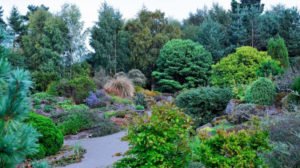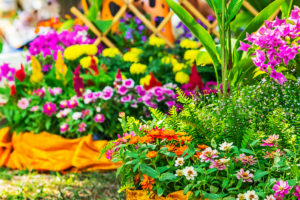
When composing garden compositions, we take care of color, interesting flowering, contrast of forms and texture of leaves. And maybe it is worth thinking about something equally important? For example, how to make a garden attractive to birds in winter?
Shrubs provide shelter for birds, their seeds give them food in autumn and winter, but perennials, attracting many species of insects, feed birds in spring, summer and autumn. We are curious to observe the habits of birds, it is pleasant to listen to their singing. Let’s help them overwinter!

All we need to do is not cut the aerial part of perennials before winter, the birds will feed on the seeds of plants.
The plan of the flower garden “Winter dining room for birds” is presented below. Each plant is marked with its own number.

Flower garden plan: 1-Eupatorium; 2-Helianthus; 3-Schizachyrium scoparium; 4-Aster; 5-Echinacea
5 plants for flower garden
There are only five perennials in our flower garden. If you like the composition, but want to plant it on a larger area, do not increase the number of species, and repeat the plan you like, using the same plants or their alternatives.
Eupatorium
Eutrochium purpureum and its varieties prefer open places, but tolerate partial shade and shade. To soils, the plant is unpretentious, but loves loose and nutritious soils; moisture-loving. Eutrochium and are propagated by seeds, dividing the Bush in autumn and spring, by cuttings. When growing from seed, there are no difficulties. Flowering occurs on 2-3 year. If you leave the faded inflorescences in the garden, you can get self-seeding.

Divide bushes in spring or late summer. Basal cuttings are cut early in the spring, stem-in the first half of summer. Often divide and transplant Eupatorium should not be, it is a durable plant; overgrown Bush looks more decorative than a young plant.
Helianthus
Helianthus ‘Lemon Queen’ is a perennial erect herb, has a strong branched leafy stem height of 150-170 cm. its leaves are dense sessile, dark green, up to 15 cm long tubular Flowers, yellow, small, collected in inflorescences-baskets 8-10 cm in diameter, large reed flowers, located on the edge, lemon-yellow. Blooms from mid-August and September.

Helianthus does not self-seed. Winter hardiness is good. Loves the sun, can withstand partial shade, but flowering will be thus weaker. Prefers fertile drained medium and light loam with a slightly acidic reaction. Almost not affected by diseases and pests. Require a transplant every 4-5 years.
Schizachyrium
Schizachyrium scoparium in the wild grows in prairies, forests, dry fields and hills of the United States and Canada, it is one of the widespread Prairie grasses. Grayish-blue foliage forms a neat straight tussock height of 60-120 cm Form varies from strictly straight at the beginning of growth to arcuate in adulthood.

The summer color of the bushes is different: some plants are bright green, others are bluish or slightly bluish, often with a noticeable purple tint. In autumn, the color changes from yellow-brown to copper-orange.
Aster
Aster ‘ Wood’s Purple’ is a perennial herb with erect, strongly branched, pubescent stems up to 30 cm tall, forming hemispherical bushes. The flowers are pink-purple. Leaves sessile, lanceolate, dark green, numerous. Blooms very abundantly in August-September for 35-40 days. Frost-resistant. The underground part of the shrub Aster ‘Wood’s Purple’ winters as a compact rhizome with many daughter buds.

Echinacea
Echinacea propagates by seeds and vegetatively. Seeds germinate without stratification, have a low percentage of germination. When sowing in may in the open ground shoots appear in 2-3 weeks, sometimes later. By the end of the first year of plant life, a rosette of leaves is formed. They bloom in the second year, flowering continues from late July — early August to September.

In the middle band, the seeds ripen only in those inflorescences that bloomed before others, if September was warm. It is preferable to sow Echinacea seeds in a greenhouse in February-March, then plant seedlings in the ground, in which case the plants can bloom in the year of sowing. Vegetatively Echinacea is propagated by rhizome division in early spring.
From snow to snow
The appearance of the flower garden changes during the season, it is most decorative in late summer and autumn. Since we create this composition for the sake of attracting birds during the autumn-winter off-season and early winter, the aerial part of perennials can not be cut at the end of autumn, so that the birds had something to eat at this difficult time of year for them.
Spring
There’s nothing interesting in the flower garden now. In the spring, you can carefully remove the stems of perennials that we did not cut for the winter. There is one trick, which is to add to the flower garden spring-flowering bulbs. This advice applies in our case! So the composition will be bright and elegant at the beginning of the season.
Summer
Eutrochium is a real garden decoration in the second half of summer, when large corymbose inflorescences appear. Wonderful compact variety ‘Little Joe’ with smoky pink inflorescences blooms in July-August for a month. Aster ‘Wood’s Purple’ blooms very abundantly in August-September for 35-40 days.
This giant-Helianthus ‘Lemon Queen’ – blooms, starting in August for 2-3 months. Summer foliage color Schizachyrium ‘Prairie Blues’, forming a neat straight tussock, bluish with a noticeable purple tint. Echinacea ‘Magnus’ blooms from July to September with large dark crimson flowers with an orange-brown convex center.
Autumn and winter
In autumn, if this has not been done before, it is recommended to mulch the soil of the flower garden. Ideal for this purpose, rotted horse manure, ripe or semi-decomposed compost, ground bark of pine or larch.
Mulch materials, covering the buds of perennials allows the plants to better survive through the winter. In the spring, compost and manure will serve as a top dressing for plants. If you need to feed perennials in the spring, mulched bark, this can be done on top of it.

Until frost continues flowering Echinacea ‘Magnus’. Faded inflorescences of Eutrochium acquire an attractive silvery-white color. In autumn, the color of Schizachyrium ‘Prairie Blues’ changes to copper-orange, elongated spikelets at the top of the stem dry and become silvery, especially attractive when illuminated by autumn or winter sun, they are good all winter, even when snow falls.
How else to attract birds to the garden
If we want our flower garden to give food to birds, it is not necessary to cut the branches of perennials for the winter, we will have time to do it in the spring. You can attract birds to the garden by installing year-round or winter feeders.

In the warm season, the diet of birds is diverse; depending on the type of food are insects, berries, fruits. To save the birds, wintering in the garden, hang feeders and regularly fill them with different seeds, the most favorite – sunflower, rich in oils and carbohydrates.
Titmice are also fed with watermelon and pumpkin seeds, pieces of unsalted fat. Birds arriving in winter to the feeder, most likely, it is in your garden will bring Chicks.
Bird feeders can be very diverse, and simple recipes for cooking treats for them a lot.
To create an unpretentious and beautiful flower garden, using only five species of plants, is very simple.




Leave a Reply